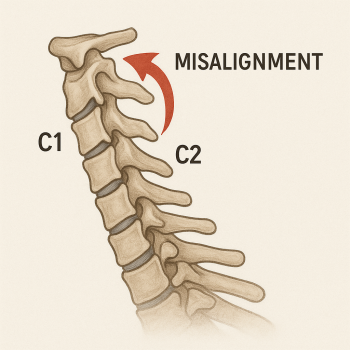
Many individuals, both adults and children, suffer with sinus pressure symptoms. These symptoms may be acute or chronic in nature and include painful pressure in the face around or behind the eyes, and often are accompanied by headaches.
Sinus pressure symptoms overlap with symptoms of other conditions and as such can lead to confusion regarding cause, appropriate treatment, and ultimately how to obtain lasting relief.
What is causing sinus pressure symptoms?
There are a number of structures in the facial region that can be affected by those with sinus pressure symptoms. Identifying the probable tissues of involvement is essential for obtaining lasting relief. The frontal sinuses are located in the forehead above the eyes.
The sphenoid sinus is located deep in the skull behind the nose, just behind the ethmoid sinuses that are situated behind the nasal cavity. The maxillary sinuses are located on either side of the nose just below the eyes extending out toward the cheekbones.
Each of these sinuses is lined by a mucosal membrane, or a moist lining that is rich with blood vessels and nerve endings. These sensitive tissues are important for warming the air coming into the lunges, filtering out particulates, and serve an immune system function by identifying pathogens and stimulating a response to fight off infection.
Sinus pressure symptoms may result from inflammation in these tissues resulting in painful pressure behind the eyes or on the face.
How are sinus pressure symptoms usually treated?
Research has identified that various types of headaches are often misdiagnosed as sinus pressure symptoms. Because of the pinpoint pain associated with these conditions, misdiagnosis is common and inappropriate treatments may occur. In fact, “sinus headache” is not a recognized clinical entity by major neurology, otolaryngology, and allergy organizations1. As such, individuals suffering with sinus pressure symptoms are left searching for answers and effective treatments with a poor understanding of their condition.
What is missing in understanding sinus pressure symptoms?
An often overlooked perspective is one that identifies the involved nerve structures of the facial region and their effect on pain across the head, neck, and face. The trigeminal nerve is the 5th of 12 cranial nerves that branches off into three divisions along the side of the face: the ophthalmic (V1), the maxillary (V2), and the mandibular (V3).
The ophthalmic branch continues to divide into smaller nerves that supply the frontal and ethmoid sinuses. The maxillary branch divides and supplies the maxillary sinuses and nasal cavity. When irritated, these delicate nerve structures can produce pain in the tissues that they supply in the same way that a pinched nerve in the neck can cause numbness/tingling down the arm and into the hand.
What affects the nerves of the face and sinuses?
The trigeminal nerve and its branches (see above) begin in the trigeminal ganglion which is a bundle of nerves that is embedded in the dura mater – the tissue surrounding the brain and the spinal cord.
This thick membrane also attaches to the bones of the upper neck and the bottom of the skull to anchor the spinal cord and to provide the “tube” that spinal fluid flows within. Irritation of this trigeminal ganglion can produce abnormal pain signaling to the sinus cavities, causing sinus pressure problems. A recent study found that sinus pressure issues are likely to be misdiagnosed headache conditions involving the trigeminal nerve.
“Seventy-six percent of migraine subjects reported pain in the distribution of the second division of the trigeminal nerve (either unilateral or bilateral), and 62% experienced bilateral forehead and maxillary pain with their headaches.2”
What causes nerve irritation?
Displacements of the bones of the upper neck produce mechanical irritation, muscle imbalance, and subsequent nerve irritation. Over time, these imbalances and irritations are likely to produce the onset of symptoms if left uncorrected.
Sinus pressure symptoms are a common side effect when the trigeminal nerve is involved, and conventional treatments are ineffective for individuals with sinus pressure symptoms that are related to nerve irritation.
How does the upper neck become displaced?
As the most mobile part of the spine, the upper cervical spine (upper neck) is prone to injury when forces affect the spine. Sports injuries, slip-and-fall accidents, motor vehicle accidents, and repetitive poor posture can produce stresses and strains around the head and neck that produce an upper cervical subluxation.
Can upper cervical subluxation be related to sinus pressure problems?
Through the mechanisms described above, a mechanical displacement of the upper bones in the neck may produce local nerve irritation that affects the nerve supply to the head and face – including the sinuses.
This nerve irritation often manifests as pain in these tissues, though the problem exists “upstream” at the upper neck region. Many upper cervical Doctors have noticed significant relief, increased drainage, and resolution of sinus pressure problems while managing patients with upper cervical subluxations.
How do I consult with an upper cervical Doctor?
Upper cervical doctors are a unique branch of chiropractic that focuses exclusively on identifying and correcting upper cervical (also known as craniocervical junction) issues. The Blair Upper Cervical Chiropractic Society teaches, trains, and certifies qualified upper cervical doctors throughout the world to handle these conditions. To find a qualified Blair Upper Cervical doctor, simply request a complimentary consultation. Our team will put you in touch with the doctor nearest you.
References:
1. Allergy Asthma Proc. 2004 Mar-Apr;25(2):95-6.
2. Headache. 2007 Feb;47(2):213-24.




Leave a comment